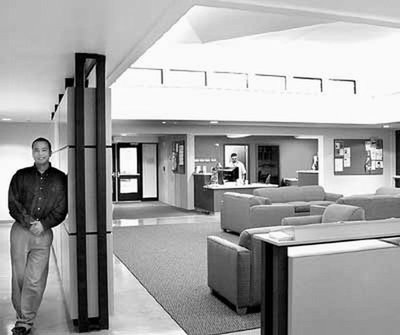October 25, 2001
Ethnic Cultural Center shows off a new look
The Ethnic Cultural Center and Theater are reopening, ready to meet the rigors of the 21st century but still deeply rooted in their history.
The public re-opening ceremonies are scheduled for 10 a.m.-4 p.m. Nov. 1 and 2.
Gone is the Center’s peaceful central courtyard, replaced by a spacious lobby and 20 percent more usable space. One of the meeting rooms has been expanded to allow for larger meetings than was previously possible. And hallways were added so students going to the offices of their various organizations will no longer need to interrupt a meeting to get to them. The center now boasts a remodeled and separate computer room. The smell of new carpets and fresh paint is everywhere.
Almost everywhere, that is. The murals that were designed and executed by students shortly after the Center’s opening in the early 1970s have been preserved. They are on the walls of the four multipurpose ethnic rooms, depicting culturally resonant themes.
“It’s the thing alumni ask about first, when we tell them the place has been remodeled,” says Luis Ramirez, director of the Ethnic Cultural Center and Theater Complex. “And we always reassure them. But the truth is, the murals are beginning to fade and need some restoration. We’ve actually begun contacting some of the original artists to see if they are interested in being part of that process.”
The heavily used structure is home to 25 registered student organizations with as many as 40 other registered student organizations using it from time to time for activities ranging from meetings and leadership conferences to cultural programming and music rehearsals. In a typical year, the center is visited by an estimated 75,000 people. Operations are supported by funds from the student activities fee. According to Ramirez, remodeling has been scheduled for at least a dozen years. But a visit by President McCormick, combined with the passage of Initiative 200, caused the administration to move the remodel up to the top of the priority list.
Construction started in January of 2001. The project was completed on schedule and the buildings were occupied prior to the start of Autumn Quarter. The original project budget of $1.5 million was later supplemented with an additional $250,000 for added improvements to the theater. The project will be completed below budget, according to Doug Jennings, senior project manager for the Capital Projects Office.
In the original building, a small lobby led to a central garden. The garden was seldom used because of the weather, and that space is now enclosed, featuring a brightly lit library and gathering space in keeping with the energetic atmosphere of the facility. Jennings complimented the architects (ARC Architects) for the use of natural light in the library area.
Remodeling the Ethnic Cultural Theater presented some special issues, according to Jennings. Necessary upgrades included the ventilation, electrical system, carpeting, stair lighting, ticket counter, stage lighting and acoustical improvements. “The theater is really shoehorned into the building, which is shared with the Office of Minority Affairs Instructional Center upstairs,” he says. Together, they occupy a site that originally housed a dog food factory. Insulation was added both above and around the theater, to minimize the effect of street noise and neighbor noise.
“We’re very excited about some of the potential programming in the theater,” says Ramirez. “We expect the theater to be the home of drama productions, symposia, lectures, shows, films, music and cultural offerings. We will work with academic departments and develop some year-long themes that will help focus the activities.”
Ramirez is proud that the center has acted as a kind of incubator for students who have risen to positions of leadership on the campus. “One of our goals is to provide opportunities for students that extend beyond classes, so they can interact with one another and the University administration. We’re happy we were able to renovate the facility without losing its integrity and the presence that makes it special.”

